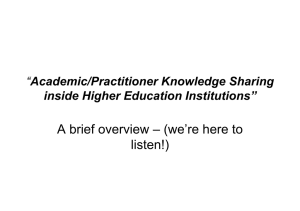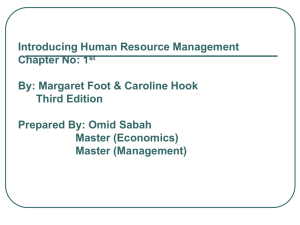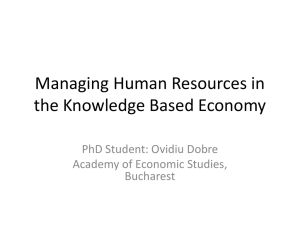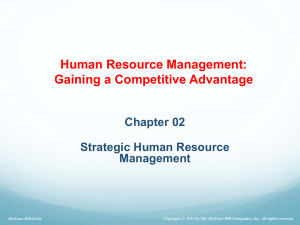chap01 - Chu Hai College
advertisement
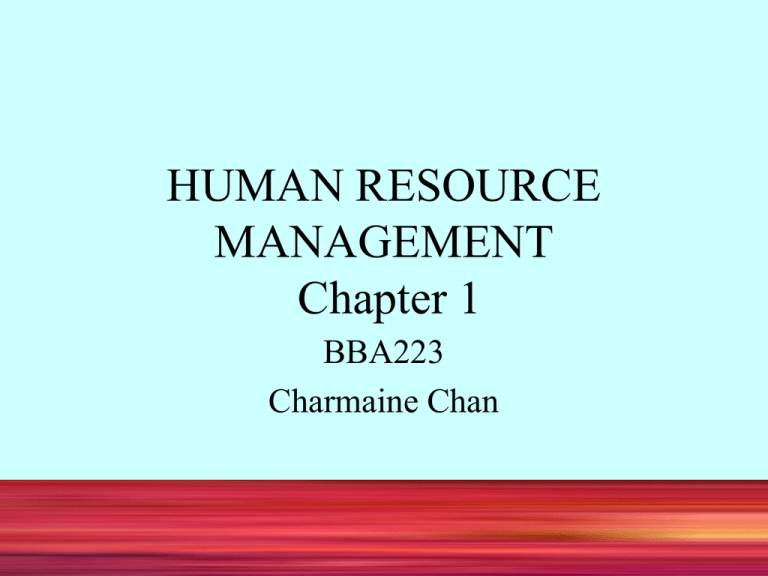
HUMAN RESOURCE MANAGEMENT Chapter 1 BBA223 Charmaine Chan WHAT IS HUMAN RESOURCE MANAGEMENT? • Managing people within the employer-employee relationship. • It involves the productive use of people in achieving the organisation’s strategic business objectives and the satisfaction of individual employee needs. • HRM is either a part of the problem or part of the solution in gaining the productive contribution of people. • The HR manager, as with any other functional manager in marketing, production or finance, is responsible for performance. • His or her position exists foremost to help achieve the strategic business objectives of the organization. • The HR function is recognised for contributing to the ‘bottom line (which refers to a final result such as net profit after taxes). HRM AND MANAGEMENT • HRM a part of management, which dealing directly with people, whereas management also includes marketing , R&D, production and accounting and finance. • Because the purpose of HRM is to improve the productive contribution of people, it is intimately related to all other aspects of management. Who is responsible for HR? • HRM functions are not necessarily executed by a HR specialist or department, can be line or operating managers. • How the HR functions are divided between the HR department’s specialists and the organisation’s other managers varies from situation to situation and depends on a vast number of circumstantial factors. Circumstantial Factors Internal factors: • organisational history, • Size, structure and location, • the values, philosophies and management styles of top management, • the nature of the workforce, • the type of industry. External factors: • economic conditions, • legislative requirements, • industrial relations. Myths that keep HR as profession Old Myths • People go into HR because they like people. • Anyone can do HR. New Realities HR departments are not designed to provide corporate therapy or to act as social or health-andhappiness retreats. HR professionals must create the practices that make employees more competitive, not more comfortable. HR activities are based on theory and research. HR professionals must master both theory and practice. Old Myths • HR deals with the soft side of business and therefore is not accountable. • HR focuses on costs, which must be controlled. • HR’s job is to be the policy police and the health-and-happiness patrol. New Realities • • • • • HR is full of fads. The impact of HR practices on business results can and must be measured. HR professionals must learn to translate their work into financial performance. HR practices must create value by increasing the intellectual capital within the firm. HR professionals must add value, not only reduce costs. The HR function does not own compliance. HR practices have evolved over time. HR professionals must see their current work as part of an evolutionary chain and explain their work with less jargon and more authority. Old Myths • HR is staffed by nice people. • HR is HR’s job. New Realities • At times, HR practices should force vigorous debates. HR professionals should be confrontative, challenging and supportive. • HR work is as important to line managers as are finance, strategy, and other business domains. HR professionals should join with managers in championing HR issues. APPROACHES TO HRM • Instrumental HRM (hard approach): stresses the rational, quantitative and strategic aspects of managing human resources. • Humanistic HRM (soft approach): while emphasizing the integration of HR practices with strategic objectives, it stresses competitive advantage is achieved by employees with superior know-how, commitment, job satisfaction, adaptability and motivation. The New Role of HR Managers STRATEGIC PARTNER • HR professionals play a strategic role when they have the ability to translate business strategy into action. This facilitating role allows the HR manager to become part of the business team. ADMINISTRATIVE EXPERT • To become administrative experts HR professionals must be able to reengineer HR activities through the use of technology, process engineering and total quality management. EMPLOYEE CHAMPION • The HR professional must be able to relate to and meet the needs of employees CHANGE AGENT • The HR manager needs to serve as a catalyst for change within the organization, which includes leading change in the HR function and by developing problem-solving communication and influence skills. In short, the HR manager must know how to manage change. HRM ACTIVITIES • Job analysis Defines a job in terms of specific tasks and responsibilities and identifies the abilities, skills and qualifications • Human resource planning or employment planning : The process attempts to ensure that it has the right number of qualified people in the right jobs at the right time. • Employee recruitment The process of seeking and attracting applicants from which qualified candidates for job vacancies • Employee selection involves choosing the appropriate candidates HRM ACTIVITIES • Performance appraisal Concerned with determining performance of employees, communicating that information to the employees and establishing a plan for performance improvement. • Training and development Activities help employees learn how to perform their jobs, improve their performance and prepare themselves for more senior positions. • Career planning and development Activities that identifies employee career goals, possible future job opportunities and personal improvement requirements, and ensuring the availability of qualified employees . • Employee motivation To motivate employees so to achieve more productivity and lower rates of absenteeism, turnover and lateness. HRM ACTIVITIES (con’t) • Compensation Refers to the cash rewards, such as the base salary, bonus, incentive payments and allowances • Benefits Refer to as indirect or non-cash compensation. • Effective health and safety programs Help guarantee the physical and mental wellbeing of employees. • Management of diversity Successfully integrating multi-cultural population into the work force maximises the contribution of all employees. WHAT IS STRATEGY • Defines the direction in which an organization intends to move and establishes the framework for action by which it intends to get there. Technological Demographic Environmental Social Cultural Legal Political ASSESS INTERNAL AND EXTERNAL INFLUENCES Business Industrial Relations Economic ORGANISATIONAL PURPOSE ORGANISATIONAL OBJECTIVES STRATEGY STRUCTURE CULTURE HUMAN RESOURCE MANAGEMENT OBJECTIVES What is to be achieved HRM AUDIT Evaluation of performance HUMAN RESOURCE MANAGEMENT STRATEGY How it is to be achieved HRM OUTCOMES Commitment Competence Cost-effectiveness Congruence Adaptability Performance Job satisfaction Motivation Trust HRM RESOURCE ACTIVITIES Acquisition Development Reward and motivation Maintenance Departure Internal environment What are our strengths? What are out weaknesses? • Skilled work force •Superior quality products • Financial strength • Excellent research and development • High labour costs • Poor industrial relations • Poor customer service • Management succession problems • Lack of international marketing expertise External environment What are our opportunities? •New markets in Asia •Low inflation •Weak competition Decentralisation of industrial Relations/enterprise bargaining SWOT analysis What are our threats? • Increased government regulation • High taxation • Domestic shortages of skilled labour • Rising costs of imported raw materials STRATEGIC INTENT • Companies that have achieved global leadership, have created a sustained obsession to achieve a challenging long-term objective. This obsession is called strategic intent. • Achieve this requires organisations to move from their traditional conscript mindset (externally motivated) to a volunteer mindset internally motivated). Strategic Intent Establish a mission and key objectives F E E D B A C K Analyse the environment Analyse and select business strategies Implement the strategies Monitor and evaluate performance TYPES OF STRATEGIES • • • • Growth Retrenchment Stability Combination HRM STRATEGY can help an organization to achieve strategic objectives by: • Recognizing the value of people in all business processes • Seeing that all concerned appreciate the HR implications of their proposals • Achieving a close match between corporate business objectives and objectives of the HR function • Designing a culture, climate and organizational processes conducive to optimal performance of staff • Identifying the firm’s distinctive competencies and the types of people that match these competencies. • Assessing the performance requirements • Reviewing levels of commitment STRATEGIC HRM OBJECTIVES CAN BE LINKED TO STRATEGIC OBJCTIVES SUCH AS: • • • • Cost containment Customer service Social responsibility Organizational effectiveness ASSESSMENT OF INFLUENCES • • • • Where are we now? Where do we want to be in the future? What path is best for us? How and when can we implement it? EXTERNAL INFLUENCES • • • • • • • • • • Political Legal Environmental Technological Cultural Demographic Social Business Economic Industrial relations INTERNAL INFLUENCES • • • • Organizational mission and purpose Objectives and strategies Organizational culture Organizational structure OUTCOMES IN EVALUATING HRM STRATEGIES AND POLICIES • • • • • • • • • Commitment Competence Cost-effectiveness Congruence Adaptability Performance Job satisfaction Employee motivation Trust





